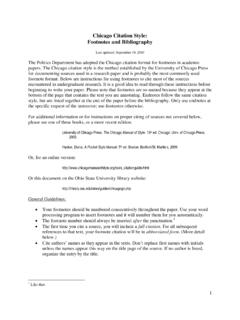Transcription of Referencing Guide : The MHRA (Modern Humanities Research ...
1 1 Referencing Guide : The MHRA (Modern Humanities Research Association) Style Prepared by J Harper, Templeman Library This document will give you basic guidelines on how to reference material according to the MHRA style. For full guidance, please consult the MHRA Style Book shelved in the Library at Z253. Many of the examples given in this document have been reproduced from that same text. Introduction The MHRA style is used in the Humanities , and particularly these disciplines: English, modern languages and literature. With MHRA, you insert any references that you wish to make within the text of your document (for example, where you have quoted from another text, or referred to another author s work), as a footnote. The resulting reference within this footnote is called a citation , and the format of the citation can vary. A list of all the references you have used is compiled at the end of the document using these citations.
2 This list is called a bibliography . The references in this bibliography are carefully formatted according to the type of material. Your bibliography should only include material that you have directly cited in your text. See the guidance on footnote citations and bibliographic references for examples. Footnotes: There should be no more than one footnote per sentence. If you are referring to more than one work in the same sentence, just place all the citations in the same footnote. Footnotes should be placed at the end of a sentence (following the full-stop, exclamation or question mark), or after a quote. You can group citations for more than one sentence together in the same footnote. However, single footnotes should not be used to group citations spanning more than one paragraph in your text. Avoid cross- Referencing ( see note 12 above or see page fifteen ) in footnotes where at all possible.
3 Only use the term ibid. where the same reference has already been given in the preceding footnote. Otherwise use the shortened formats for later footnote citations, given in this document. See the paradigms on the following page for exemplars of layout. 2 Quoting in the body of your text: The source of quotations within your text must always be clearly identified (so the reader can use the bibliography to identify the original work the quote was taken from), and a page reference if appropriate. Direct quotations in the body of your text should not exceed forty words of prose, or two complete lines of verse, and must be enclosed within single quotation marks. Where quotations span more than one line of verse, indicate the line break with an upright | . Indicate omitted text using an ellipsis [..]: [..] the mythical romance of Aengus searching for his love, Though I am old with wandering | Through hollow lands and hilly lands (lines 17-18) Quotations within a quotation should use double quotation marks.
4 [..] Dickens initially defines the violent nature of Bill Sikes character through others deference to him Well, well, then Bill Sikes , said the Jew, with abject humility (p. 87).2 Longer quotations should be set into the body of your document, as a separate paragraph, with an additional line break between it and the preceding and following lines of text. The quotation may also be either indented or set in a smaller font size to further distinguish it. The quotation paragraph does not have to be enclosed within quotation marks. However, additional quotations within it should use single quotation marks. Format quotes from plays or verse as it is laid out in the original text. End the quotation with a full-stop, exclamation mark or question mark. Put additional references (page, paragraph, section, act, scene or line numbers) outside this in parentheses. Finally, place the footnote entry at the end of the quotation: S.
5 Patrick s unspoken condemnation of the pagan Fenians and their warlike existence - setting Irishman against Irishman - seems ironic in a modern context when we consider that the source of much conflict in Ireland s history has been Christianity Yeats explores these tensions between the heathen, golden age of the Fenian warriors, and Christian Ireland, and by extension, notions of Irish nationhood, in his early, epic poem: S. Patrick. On the flaming stones, without refuge, the limbs of the Fenians are tost; None war on the masters of Hell, who could break up the world in their rage; But kneel and wear out the flags and pray for your soul that is lost Through the demon love of its youth and its godless and passionate age. (Book III, 213-16)4 Themes of Irish independence are more obviously expressed in his later political poems, Romantic Ireland s dead and gone, | It s with O Leary in the grave.
6 5 1 William Butler Yeats, 'The Song of Wandering Aengus', in Yeats the Major Works, ed. by Edward Larrissy, rev. edn (Oxford: Oxford University Press, 2001). 2 Charles Dickens, Oliver Twist, ed. by Steven Connor and Michael Slater, Everyman's Library, Rev. edn (London: , 1997). 3 John Wolffe, God and Greater Britain: Religion and National Life in Britain and Ireland, 1843-1945 (London; New York: Routledge, 1994), pp. 73-91. 4 'The Wanderings of Oisin', in Yeats the Major Works (see Yeats above). 3 In-text Author/Date references (citations): Occasionally, MHRA allows the use of in-text author/date citations rather than footnotes in order to reference material that you have quoted or referred to. Check your departmental handbook to see if this is acceptable. In such instances, the in-text citations will follow a similar format to those applied with the Harvard style of Referencing : Single author Insert the author s surname and publication year (both inside parentheses) [.]
7 ] as seen in the characterisation of Raskolnikov (Dostoyevsky 1993). Multiple authors Separate author names with a comma, precede last author name with & thus: [..] identified in the canon of Sartre s work (Austin, Rees & Vinaver 1961). 4 or more authors Use first author s surname and the abbreviation et al. thus: [..] the subtle distinctions between nineteenth century French and English high culture (Harkness et al. 2003). Works published by the same author in the same year Add a letter sequence to the year (a, b, c, d, etc.), and arrange the references in the bibliography according to this sequence: [..] articulated in a recent essay on the French dramatists (Smith 1997a). Works published by different authors with the same name, in the same year Add initials to the author surname, or additional author names (and initials, if necessary) until the citation becomes unique: [..] the impact of social change on nineteenth century French playwrights (Smith, J 1997).
8 Addition of page references Add the page reference to the parenthetical citation using a colon following the [..] in the history of German literary criticism (Hohendahl 1988: 217). 5 'September 1913', in Yeats (see Yeats above), 7. 4 Author s name already given in sentence Include just the year (and page reference, if applicable) inside parentheses: [..] an essay by Fenk Oczion puts forward an entirely different view (1994: 283). Year already given in sentence Include just the author name (and page reference, if applicable) inside parentheses: [..] an earlier essay from 1994 puts forward an entirely different view (Oczion: 283-89). References to multiple works within the same citation Separate each citation within the parenthesis with a comma: [.]
9 ] shown by a series of intense studies of the author s work (Smith 1990, Jones & Parkin 2002: 23, Allen 2005). Author cited in another work (secondary citation ) Try to avoid this where possible, it is not good practice to cite material that you have not directly read yourself. You should always try to find the original publication. Where unavoidable, refer to the original author, but make it clear that the source of your information is another author and publication, [..] A study by Schneider indicates that working is important to the self-esteem, of residents recently released from long term institutions (cited by Forrester Jones et al. 2002: 755). [..] Forrester Jones et al. refer to Schneider s study on self esteem (2002). (where Schneider is the original author, and Forrester Jones is the work the original author is mentioned in). Similarly, [..] In response to Woolf s comment that they were not as good as Keats, is said to have replied, Yes we 're trying something harder (Nicholson & Trautmann 1976: 237).
10 No author Use the title in place of the author name: [..] accepted definition given (Collins German-English Dictionary 1993). The footnote citations, bibliographic references and bibliography itself will be formatted according to the examples given in the next sections. 5 Footnote citations and bibliographic references: Footnote citations should include all the bibliographic details of the item referred to or quoted. Include page, paragraph, section, act, scene or line numbers as appropriate. Footnote citations should be formatted according to the conventions in the table which follows this section. Where the footnote citation is repeated in your document, the reference may take an abbreviated form. Your bibliography is an alphabetical list of references to every work cited in your document. The references in your bibliography will be derived from the citations made in your footnotes (or in the body of your text, if you are using the author-date system).















